Infectious diseases. Later, general, then geriatric
In 1897 the Prince of Wales opened the Park Fever Hospital at Hither Green. It was the fourth of the five new fever hospitals built by the Metropolitan Asylums Board following a shortage of beds during an epidemic of scarlet fever in 1892-93 (the first was the North Eastern Hospital in Tottenham, built in 1892, the second the Fountain Hospital in Tooting, built in 1893 and the third the Brook Hospital, Shooter's Hill, built in 1896).
Built on a 19-acre site previously occupied by a large house and its grounds, it was the largest fever hospital in England at that time. It had 548 beds and a staff of 3000, and had cost £280,000 to build. The Hospital had large 20-bedded wards for scarlet fever patients and smaller wards for those with diphtheria and enteric infections. Included in the campus were receiving and isolation wards, as well as staff quarters, a laundry, a boiler house and other utility buildings. The cluster of buildings by the Hospital entrance included a 2-storey porter's lodge, the medical superintendent's house, an office and discharge and waiting rooms. The medical education block and the mortuary were nearby.
By 1910 the number of fever cases had declined and the Hospital was closed for disinfection and renovation. It opened at the end of the same year as the Park Hospital for Children, a convalescent home for sick children from London Poor Law infirmaries.
In November 1914 it reverted to being a fever hospital, the children having been sent to the newly established Goldie Leigh Homes. At the beginnning of WW1 the Hospital admitted war refugees; some 650 beds were in use, although there was the capacity for 800.
In 1930 the LCC took over administrative control.
At the beginning of WW2 in 1939 the Hospital had 632 beds. It was severely damaged by bombing during the war.
In 1948 it joined the NHS under the Lewisham Group Hospital Management Committee and was renamed the Hither Green Hospital in 1950.
By 1953 the Hospital had 500 beds. Although still a fever hospital, it was being used also for medical patients and for those with skin disorders. A ward was opened for patients undergoing tonsil and adenoids operations.
During the polio epidemic in the early 1950s some 210 patients suffering from the disease were admitted. In 1955 a hydrotherapy pool was built at a cost of £950 for their use.
Negotiations began in 1956 to unite the Hospital with St John's Hospital in Lewisham. The amalgamation was completed during the 1960s.
As well as treating general medical cases, infectious diseases and ENT patients, the Hospital began to treat eye cases when the Group Ophthalmic Unit with 20 beds opened in 1961.
In 1965 a new modern extension was added to the Nurses' Home (which had originally been built in 1897).
In November 1967 another major train crash occurred at Hither Green station, with 53 killed and 90 injured. The casualties were taken to Hither Green Hospital and to Lewisham Hospital.
In 1968 a consultant geriatrician was appointed and a new 38-bedded Assessment Unit opened.
In 1970 The Geriatric Department was enlarged and a Day Hospital opened. In 1973 Sir Keith Joseph, the Secretary of State for Health and Social Services, opened 'Birdwood', the Younger Disabled Unit.
By the late 1970s the Hospital began specialising in the treatment and care of psychogeriatric patients.
In 1980 a new laundry was built to replace the one destroyed by fire in 1974.
By 1992 only part of the Hospital was in use for the care of elderly and psychiatric patients.
It closed in 1997, a century after it had opened. The Care of the Elderly services transferred to Lewisham Hospital.
Present status (January 2008)
The site was bought by Bellway Homes, who demolished the buildings on the eastern side in 2001, and built residential housing at the northern part.
The remainder of the site - some 11 acres - contains the locally listed water tower and some of the old Hospital buildings by the entrance. Development of this area was in dispute with the local residents for a long time because of fears of overcrowding, but eventually the new homes were built.
The Hospital site is now a £28m housing complex known as Meridian South (the Greenwich meridian line runs through the estate). It contains 442 new homes, but it seems the promised gym and most retail outlets have yet to materialise.
Update: November 2014
An indoor Swedish Felt Minigolf Course opened in 2010.
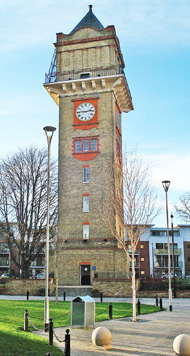
The restored water tower with its clock in the central piazza.
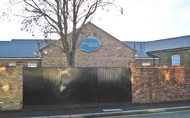
All that remains of health care on the site is the newly built Woodlands Health Centre.
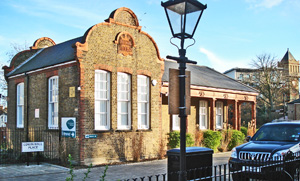
Surviving buildings at the corner of George Lane and Hither Green Lane (above and below).
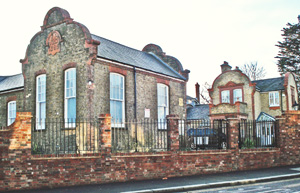
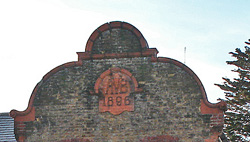
The plaque on the gable states "MAB 1896".
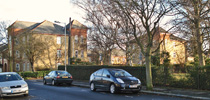
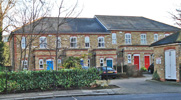
N.B. Photographs obtained in August 2014
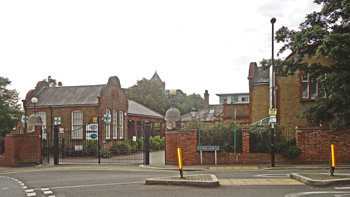
The entrance off George Lane.

The restored buildings by the entrance (above and below).
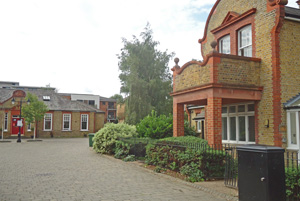
(Author unstated) 1998 A Rich Past...An Exciting Future. London, The Lewisham Hospital NHS Trust.
http://en.wikipedia.org
http://hidden-london.com
http://viewfinder.english-heritage.org.uk
http://wellcomeimages.org
www.aim25.ac.uk
www.flickr.com
www.geograph.org.uk
www.hithergreen.towntalk.co.uk
www.ideal-homes.org.uk
www.kingscollections.org
www.tomroyal.com
www.workhouses.org.uk
Return to home page